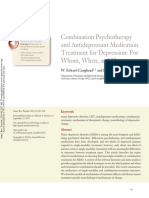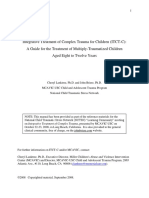Psychodynamic Theories of Offending
Psychodynamic Theories of Offending
Uploaded by
ernie moreCopyright:
Available Formats
Psychodynamic Theories of Offending
Psychodynamic Theories of Offending
Uploaded by
ernie moreOriginal Description:
Original Title
Copyright
Available Formats
Share this document
Did you find this document useful?
Is this content inappropriate?
Copyright:
Available Formats
Psychodynamic Theories of Offending
Psychodynamic Theories of Offending
Uploaded by
ernie moreCopyright:
Available Formats
Criminological psychology
Psychodynamic theories of offending
Psychodynamic theories of offending
Freuds theory of the psyche
In Freuds psychodynamic theory personality (or the psyche) has three distinct components: the id,
representing primitive desires and the need for gratification, the superego, representing moral and
social constraints, and the ego, representing reality and the ability to delay gratification. Within this
framework it is the role of the ego to strike a balance between the demands of the id and the
constraints imposed by the superego. This is primarily achieved through the use of defence
mechanisms that allow the ids desires to be satisfied in ways that the superego finds acceptable.
To a Freudian, then, behaviour that lies outside what society regards as acceptable be it
abnormal or criminal is the result of abnormal development of the psyche. Since, in classical
Freudian theory, the structure of the psyche is determined in the first five years of life, it follows that
the roots of offending are also to be found in this period, especially in the relationship between the
developing child and its parents. The Freudian framework implies a number of possible causes for
later criminal behaviour.
A weak superego
The superego is the moral regulator of behaviour. It develops at the end of the phallic stage (about
5 years) as the child internalises its same-sex parent in order to resolve the Oedipus complex. The
superego continues to act as a parent within the psyche. It punishes the ego with anxiety when an
immoral act is contemplated and with guilt of the act is carried out. A weak superego, developed as
a result of abnormal relationships within the family, would result in a person with few if any of the
usual inhibitions against antisocial behaviour. They would act in ways that gratified their id,
regardless of the social restraints on doing so.
A deviant superego
Alternately, a child might develop a superego in the normal way, but the superego itself has deviant
values. The superego is an internalization of the same sex parent so as a moral regulator it
threatens and punishes those behaviours that the parent would find unacceptable. Consequently, a
son raised normally in a family with a criminal father might develop a superego that does not react to
criminal acts that the father would engage in.
A strong superego
It seems counterintuitive that a strong superego could increase a persons risk of offending when
the superego is the regulator of moral behaviour but there are at least two ways in which this might
happen. An excessively powerful superego would render a person anxious and guilty much of the
time, since every time they acted on the ids desires however innocuously their superego would
punish them for it. This could result in a person committing crimes in order to get caught and
punished to assuage the guilt imposed by their own superego. Alternately, an excessively strong
superego might prevent the person from expressing any of the antisocial impulses that inevitably
build up in their unconscious. Normally, they would express these impulses harmlessly through
defense mechanisms (e.g. by sublimating their aggression into sport). If the superego prevents this
from happening the aggression or sexual desire could build up over time until it becomes strong
enough to overwhelm the ego and is expressed suddenly and violently as murder or rape.
Megargees overcontrolled violent offender
Megargee (1966) documented a series of cases of violence carried out by people who were
regarded as passive and harmless. For example, an 11 year-old boy who stabbed his brother 34
times with a steak knife was described as polite and softly spoken with no history of aggression
(Gross, 1996). Megargee argued that such cases represent a distinct sub-group of violent offenders
Aidan Sammons
psychlotron.org.uk
Criminological psychology
Psychodynamic theories of offending
whose shared characteristic is an apparent inability to express their anger in normal ways and who
eventually explode and release all their anger and aggression at once, often in response to a
seemingly trivial provocation. Freudian formulations like Megargees are unfashionable nowadays
and more research attention is given to the majority of violent offenders, whose problem is generally
a lack of inhibition of their anger, rather than too much inhibition. Nonetheless, there is evidence
that a subset of violent offenders follow the pattern described by Megargee. Blackburn (1971), for
example, found that people convicted of extremely violent assaults tended to have fewer previous
convictions and scored lower on measures of hostility than those convicted of moderately violent
assaults. However, the existence of such a group does not in itself show that Megargee was correct
about the underlying mechanisms responsible. In particular, Megargees approach does not
adequately distinguish whether such offenders do not experience anger normally (as the
psychodynamic approach would suggest) or whether they experience it but do not do not express it
(Blackburn, 1993).
Bowlbys affectionless psychopath
Another psychodynamically inspired explanation of offending comes from Bowlby (1951) although
Bowlby was also influenced by ethology and evolutionary theory. Bowlby proposed that the ability
to form meaningful social relationships in adulthood was dependent on a close, warm and
continuous relationship with the mother in the first few years. Since this relationship acts as the
prototype for all future relationships, its disruption would impair the persons ability to relate to
others. This could result in a condition Bowlby called affectionless psychopathy. Bowlby
presented evidence that early maternal deprivation was related to later criminal behaviour, notably
through his famous 44 Thieves study in which he reported that 39 per cent of a group of juvenile
delinquents has experienced significant disruption to their attachments, compared to only 5 per cent
of a non-delinquent group. Such evidence notwithstanding, it is no longer widely accepted that
there is such a clear causal link between maternal deprivation and offending. Bowlbys empirical
research has been criticised for unrepresentative sampling and poor control group matching. Later
theorists, particularly Rutter (1971). have pointed out his failure to distinguish between deprivation,
privation and the distortion of attachments, each of which may have different effects. Overall, he is
now regarded to have overestimated the impact of early life experiences on later offending.
Evaluation of the psychodynamic approach
Psychodynamic theories of offending are no longer widely accepted by psychologists, for a number
of reasons. First, there is the difficulty associated with testing some of the concepts.
Psychodynamic theories rely heavily on concepts like the unconscious mind, whose existence is
difficult if not impossible to prove. Second, there is a tendency for psychodynamic theories to be
able to explain any behaviour but only after it has happened. As a result, these theories are
regarded by many as unprincipled and, since they are incapable of being proved wrong, unscientific.
Third, psychodynamic researchers rely heavily on qualitative case studies in which the subjects
behaviour is interpreted in symbolic terms. This is a highly subjective process: two different analysts
may draw very different conclusions from the same set of observations. This type of evidence
makes scientists, who prefer quantifiability and objectivity, rather uneasy. Fourth, psychodynamic
therapies that have attempted to treat offending have not been successful (Howitt, 2009), besides
being extremely time consuming.
It is important not to overlook the positive contributions that psychodynamic theories have made to
criminological psychology. Psychodynamic researchers have pointed to the importance of
childhood experiences and parent-child relationships as an influence on offending (Blackburn, 1993)
and have identified many important variables relating to delinquent behaviour in adolescence (Hollin,
1989). So whilst its theoretical explanations have fallen out of favour, the psychodynamic tradition
should be credited with pointing in some useful directions for later researchers to follow.
Aidan Sammons
psychlotron.org.uk
You might also like
- Criminal Law - Arts 1-20Document73 pagesCriminal Law - Arts 1-20KrisLarr100% (5)
- Introduction To PsychiatryDocument15 pagesIntroduction To PsychiatryKulgaurav RegmiNo ratings yet
- Psychological Approaches To Bipolar Disorders: A Theoretical CritiqueDocument22 pagesPsychological Approaches To Bipolar Disorders: A Theoretical CritiqueGary CadfaelNo ratings yet
- Tavistock and Portman E-PRINTS Online: Book Chapter Original CitationDocument24 pagesTavistock and Portman E-PRINTS Online: Book Chapter Original CitationSvetoPetrovićNo ratings yet
- NeuroFeedback Mike CohenDocument39 pagesNeuroFeedback Mike Cohenernie moreNo ratings yet
- Administrative Law Questions and AnswersDocument5 pagesAdministrative Law Questions and Answersaronyu29% (7)
- Shipwrecked On Ten Islands With Clintons & BransonDocument43 pagesShipwrecked On Ten Islands With Clintons & Bransonrenagonc100% (1)
- Court Negative Averment Format Traffic TicketDocument7 pagesCourt Negative Averment Format Traffic Ticketbperky100% (7)
- Schmid Response To Plaintiff's Motion To Reconsider PDFDocument152 pagesSchmid Response To Plaintiff's Motion To Reconsider PDFJordan Tank100% (1)
- CV Vivek Benegal 0610Document16 pagesCV Vivek Benegal 0610bhaskarsg0% (1)
- PTSDDocument17 pagesPTSDadrianaNo ratings yet
- Anxiety EssayDocument9 pagesAnxiety EssayHero HypnotherapyNo ratings yet
- Combination PsychotherapyDocument37 pagesCombination PsychotherapyElija MansonNo ratings yet
- Screening Youth For Suicide Risk in MediDocument6 pagesScreening Youth For Suicide Risk in MediPánico FaunoNo ratings yet
- Psychological Formulation and Treatment PlanDocument26 pagesPsychological Formulation and Treatment Planzwidofhela363No ratings yet
- Suicide Prevention Strategies Revisited 10-Year SystematicDocument14 pagesSuicide Prevention Strategies Revisited 10-Year Systematicmary morelliNo ratings yet
- Suicide-ICM II 2012Document11 pagesSuicide-ICM II 2012Joshua ObrienNo ratings yet
- 508 Suicide Prevention Paper FinalDocument46 pages508 Suicide Prevention Paper FinalMaria Magdalena DumitruNo ratings yet
- PsychiatryDocument45 pagesPsychiatryJha K SujitNo ratings yet
- PP + CBTDocument8 pagesPP + CBTLev FyodorNo ratings yet
- E Book PDFDocument26 pagesE Book PDFAnaNo ratings yet
- Exposure and Response PreventionDocument6 pagesExposure and Response PreventionshobaNo ratings yet
- Clinical Interview: Gemah Nuripah, Dr. SPKJ, M.Kes Bagian Psikiatri FK UnisbaDocument35 pagesClinical Interview: Gemah Nuripah, Dr. SPKJ, M.Kes Bagian Psikiatri FK UnisbaShelly Dwi SilvitaNo ratings yet
- AntipsychoticsDocument36 pagesAntipsychoticsGlory MimiNo ratings yet
- Control Problems in Experimental ResearchDocument108 pagesControl Problems in Experimental ResearchAyesha AyubNo ratings yet
- Castonguay+et+al+ 1996Document8 pagesCastonguay+et+al+ 1996Pamela Cortés PeñaNo ratings yet
- Psychopathologies and Their TreatmentsDocument47 pagesPsychopathologies and Their TreatmentsLuther BlissettNo ratings yet
- Kaplan & Sadock's Comprehensive Textbook of Psychiatry, 7th EditionDocument5 pagesKaplan & Sadock's Comprehensive Textbook of Psychiatry, 7th EditionLendatu Kristiana RambaNo ratings yet
- Ictc C Treatment ManualDocument124 pagesIctc C Treatment ManualJack KomerNo ratings yet
- Planning, Organizing, Leading, ControlingDocument2 pagesPlanning, Organizing, Leading, ControlingAnonymous eGU01arDvNo ratings yet
- Drugs Used To Treat Bipolar Disorder: By: DR Satar OstadhadiDocument31 pagesDrugs Used To Treat Bipolar Disorder: By: DR Satar OstadhadiSattar OstadhadiNo ratings yet
- Psychotherapy TypesDocument36 pagesPsychotherapy TypessilencedurevesNo ratings yet
- Comparison Bet ICD & DSM PDFDocument18 pagesComparison Bet ICD & DSM PDFTiffany SyNo ratings yet
- Forensic Psychology (Syllabus)Document4 pagesForensic Psychology (Syllabus)Anirudh RanaNo ratings yet
- Psychiatry DiagnosisDocument4 pagesPsychiatry DiagnosisdrqubitNo ratings yet
- CBT View of Human NatureDocument6 pagesCBT View of Human NatureAliya MalhotraNo ratings yet
- Mood StabilizerDocument56 pagesMood StabilizerCoass BonamNo ratings yet
- MBT-I ManualDocument48 pagesMBT-I ManualLaura AndreiNo ratings yet
- Review of The Worldwide Epidemiology of Eating DisordersDocument4 pagesReview of The Worldwide Epidemiology of Eating DisordersInês RodriguesNo ratings yet
- Panic SAEBDocument1 pagePanic SAEBpanickedchick100% (1)
- Lecture No8 Ab Salgado - Crisis InterventionDocument19 pagesLecture No8 Ab Salgado - Crisis InterventionRellie Castro100% (1)
- Introduction in Clinical Psychology: PsychopharmacologyDocument67 pagesIntroduction in Clinical Psychology: PsychopharmacologyŞterbeţ RuxandraNo ratings yet
- Suicidio CBT PDFDocument17 pagesSuicidio CBT PDFMauricio HarkerNo ratings yet
- HowTherapeutic Communities Work: Specific Factors Leading To Positive OutcomeDocument11 pagesHowTherapeutic Communities Work: Specific Factors Leading To Positive OutcomeKenneth Arctander JohansenNo ratings yet
- Adolescent Depression Literature ReviewDocument8 pagesAdolescent Depression Literature ReviewShowbiz ExposeNo ratings yet
- PSPA3714 Chapter 3 2021Document65 pagesPSPA3714 Chapter 3 2021Kamogelo MakhuraNo ratings yet
- Persons Case Formulation ArticleDocument11 pagesPersons Case Formulation ArticleMarco Sousa100% (2)
- Theories of AggressionDocument15 pagesTheories of AggressionArva Glazel Defensor GallofinNo ratings yet
- Aversion TherapyDocument4 pagesAversion Therapyamagra993023100% (1)
- Psychiatry Attachment GuideDocument15 pagesPsychiatry Attachment GuideIlyani RahimNo ratings yet
- Cognitive Behavorial Therapy PDFDocument6 pagesCognitive Behavorial Therapy PDFViannys PaterninaNo ratings yet
- Personallity Disorder BMJDocument7 pagesPersonallity Disorder BMJDiego Alarcón SeguelNo ratings yet
- Chapter 1 Developmental PsychopathologyDocument30 pagesChapter 1 Developmental PsychopathologyLAVANYA M PSYCHOLOGY-COUNSELLINGNo ratings yet
- The Management of Acute DystonicDocument2 pagesThe Management of Acute DystonictaqinosNo ratings yet
- Anxiety Disorders Interview Schedule For dsm-5Document4 pagesAnxiety Disorders Interview Schedule For dsm-5Antonio ChirinoNo ratings yet
- PSYCHIATRYDocument13 pagesPSYCHIATRYapi-19863548No ratings yet
- Lecture No. 2 Semiology of Psychiatry Part 1Document33 pagesLecture No. 2 Semiology of Psychiatry Part 1ozgur.yonlukNo ratings yet
- Psychiatry: A Case Analysis in Course IntegrationDocument40 pagesPsychiatry: A Case Analysis in Course IntegrationMcleo OaferinaNo ratings yet
- A Guide To Assessments That Work - (Part V Substance Use and Gambling Disorders)Document199 pagesA Guide To Assessments That Work - (Part V Substance Use and Gambling Disorders)al436796No ratings yet
- CatatoniaDocument17 pagesCatatoniaakelog getahunNo ratings yet
- Identifying and Developing Therapeutic Principles For Trauma Focused Work in Person-Centred and Emotion Focused TherapiesDocument31 pagesIdentifying and Developing Therapeutic Principles For Trauma Focused Work in Person-Centred and Emotion Focused TherapiesChih Chou ChiuNo ratings yet
- Salkovskis Undesrstanding and Treating OCD 1999 PDFDocument24 pagesSalkovskis Undesrstanding and Treating OCD 1999 PDFMannymorNo ratings yet
- BSC Psychology 2017Document65 pagesBSC Psychology 2017THOMAS NJNo ratings yet
- Medical Conditions Associated with Suicide Risk: Amputation and Suicide: Medical Conditions Associated with Suicide Risk, #15From EverandMedical Conditions Associated with Suicide Risk: Amputation and Suicide: Medical Conditions Associated with Suicide Risk, #15No ratings yet
- Ethical Issues in Clinical Forensic PsychiatryFrom EverandEthical Issues in Clinical Forensic PsychiatryArtemis IgoumenouNo ratings yet
- Suicide in Jails and Prisons Preventive and Legal Perspectives: A Guide for Correctional and Mental Health Staff, Experts, and AttorneysFrom EverandSuicide in Jails and Prisons Preventive and Legal Perspectives: A Guide for Correctional and Mental Health Staff, Experts, and AttorneysNo ratings yet
- Clinical Psychology ReportDocument33 pagesClinical Psychology Reporternie moreNo ratings yet
- Aggression and Violent BehaviorDocument11 pagesAggression and Violent Behaviorernie moreNo ratings yet
- Detecting Malingering On The MMPI-2 - An Examination of The Utilit PDFDocument56 pagesDetecting Malingering On The MMPI-2 - An Examination of The Utilit PDFernie moreNo ratings yet
- Evidence LSG Bar Ops ReviewerDocument39 pagesEvidence LSG Bar Ops Reviewercmv mendozaNo ratings yet
- Announcement: Item Lastname Firstname Mi Gender CenterDocument14 pagesAnnouncement: Item Lastname Firstname Mi Gender CenterEli Benjamin Nava TaclinoNo ratings yet
- GR 188611Document12 pagesGR 188611James PerezNo ratings yet
- Diversion: Q: What Is Diversion?Document6 pagesDiversion: Q: What Is Diversion?Dbee DveeNo ratings yet
- Milton Escamilla-Iraheta, A039 258 200 (BIA July 13, 2015)Document6 pagesMilton Escamilla-Iraheta, A039 258 200 (BIA July 13, 2015)Immigrant & Refugee Appellate Center, LLCNo ratings yet
- Release Waiver and Quitclaim: Know All Men by These PresentsDocument2 pagesRelease Waiver and Quitclaim: Know All Men by These Presentskarla126No ratings yet
- 003 - Kuizon v. DesiertoDocument2 pages003 - Kuizon v. DesiertoFrente Sur Melliza100% (1)
- FINAL PETITION in Support of Michael Martin ClarkDocument2 pagesFINAL PETITION in Support of Michael Martin ClarkJertaylor593No ratings yet
- Coerced Confessions The Discourse of Bilingual Pol... - (PG 13 - 122)Document110 pagesCoerced Confessions The Discourse of Bilingual Pol... - (PG 13 - 122)maria_alvrzdNo ratings yet
- Times Leader 07-31-2013Document35 pagesTimes Leader 07-31-2013The Times LeaderNo ratings yet
- Crim Pro Cases 1Document59 pagesCrim Pro Cases 1patricia guillermoNo ratings yet
- CIA Kennedy AssassinationDocument76 pagesCIA Kennedy Assassinationmika2k01100% (6)
- ConstiDocument248 pagesConstiDani McstNo ratings yet
- Goyena vs. Ledesma Gustilo - G.R. No. 147148 - January 13, 2003Document9 pagesGoyena vs. Ledesma Gustilo - G.R. No. 147148 - January 13, 2003Nikki BinsinNo ratings yet
- Jack Walton Taylor v. Ray H. Page, Warden, Oklahoma State Penitentiary, 381 F.2d 717, 10th Cir. (1967)Document4 pagesJack Walton Taylor v. Ray H. Page, Warden, Oklahoma State Penitentiary, 381 F.2d 717, 10th Cir. (1967)Scribd Government DocsNo ratings yet
- Plea Bargaining in TanzaniaDocument52 pagesPlea Bargaining in TanzaniaSelestine Jonathan100% (6)
- Legal Ethics 1st WaveDocument98 pagesLegal Ethics 1st WaveHaru RodriguezNo ratings yet
- ACP Rajbir Singh Murder Case JudgementDocument158 pagesACP Rajbir Singh Murder Case JudgementSampath Bulusu100% (2)
- Types of Home Security SystemDocument17 pagesTypes of Home Security SystemAlarvac SystemsNo ratings yet
- Solution-Focused Therapy in PrisonDocument15 pagesSolution-Focused Therapy in Prisonsolutions4family100% (1)
- Term Paper in PaleDocument6 pagesTerm Paper in PaleStar Pascual-AgustinNo ratings yet
- Sandiganbayan Jurisdiction: Daniel Emerson B Ong Based On The Book of Riano and Discussion of Atty. Soleng - 2017Document8 pagesSandiganbayan Jurisdiction: Daniel Emerson B Ong Based On The Book of Riano and Discussion of Atty. Soleng - 2017Anonymous VQ1n5zWtNo ratings yet
- Julian Vs DBPDocument12 pagesJulian Vs DBPDino MacavintaNo ratings yet
- Monica Lemus, A089 392 828 (BIA March 9, 2017)Document8 pagesMonica Lemus, A089 392 828 (BIA March 9, 2017)Immigrant & Refugee Appellate Center, LLCNo ratings yet
- Appointment of Inspectors: .-The Appropriate Government May, by Notification in TheDocument3 pagesAppointment of Inspectors: .-The Appropriate Government May, by Notification in TheBharat AhujaNo ratings yet





























































































